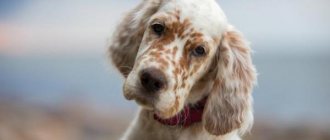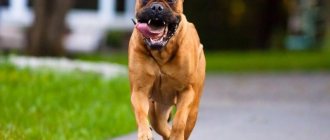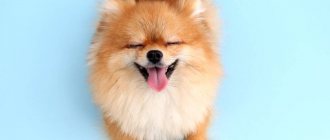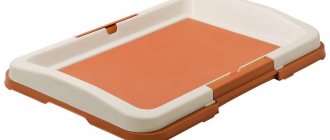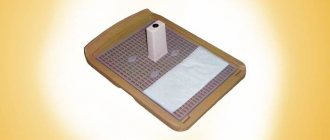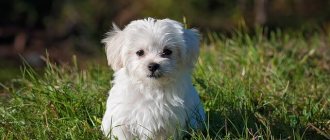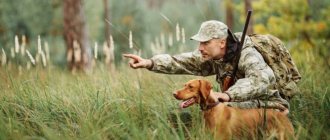Shorthair
Short-haired dog breeds are the most popular nowadays, since they can be kept in any apartment, and there is almost no grooming. We will look at dog breeds with photos and descriptions below.
Dogo Argentino
The Argentine dog is considered the only breed that was developed and recognized in Argentina. This breed is distinguished by its endurance and strong character, as it was obtained through the selection of mastiffs, bulldogs and mastiffs. The main purpose of the Great Dane is hunting and protecting the home. Now it can be used as a fighting dog or a hound. The coat is white, smooth. Average weight – 45 kg.
English bulldog
Another medium-sized short-haired breed, the English Bulldog, first appeared in England in the 19th century. The dog is distinguished by restraint, ingenuity, isolation and responsibility. Previously, the English bulldog was used for fighting, now as a decorative pet. The coat is short brindle, red, and white. Average weight – 24 kg.
What affects the color of an animal
First of all, of course, it is genetics. The color of a companion depends on combinations of many genes. Some are responsible for the distribution of pigment throughout the hair, others for the saturation of dark shades, and others for the presence of color in general. Moreover, it should be taken into account that some genes may be in a suppressed state. For example, when mating two dogs with a light color, you can get a whole variety of shades, since a gene that was received from grandparents, but did not manifest itself, may come to the fore.
With the red color, everything is simpler: the gene that sets it is always dominant, therefore, when crossing two red dogs (even with admixtures of other genes), red puppies are always born. Due to this, there are many dog breeds for which red-colored coats are the only acceptable ones according to the standard.
Also, the color of the coat depends on the care and living conditions of the animal. For example, black dogs may develop a reddish tint when exposed to sunlight for a long time. In white pets, the appearance of red coloring is usually associated with diet. Carrots and beets can give this effect. Incorrect use of tinted shampoos can lead to color changes.
Long-haired dog breeds
Afghan Hound
The Afghan Hound has much in common with the Saluki; the breed originated in Afghanistan and was used for guarding and service. The average weight of a pet is 35 kg. The breed is distinguished by its long coat of cream, beige with black markings. By nature, they are patient, obedient, devoted and savvy animals who love children.
Read: Super premium food.
Bobtail
The bobtail first appeared in England, the name translates as “Old English Sheepdog.” Previously, the breed was used for grazing livestock, now as a companion. The size of the bobtail is large, the coat is long, thick with curls. The main shade is gray with blue, marble, blue with black. The character is characterized by kindness, sociability and attentiveness. The peculiarity of the animal is its loud bark.
Yorkshire Terrier
The Yorkshire Terrier dog is a small, decorative dog that originated in England and is considered one of the most popular pets in the world. The animal's coat is long, silky, and becomes lighter with age. The main color is golden, bronze, cream, often several shades at once. The terrier is distinguished by fearlessness, courage, activity, and playfulness.
Collie
Collie (Scottish Sheepdog) is a medium breed of dog, bred for herding livestock in England and Scotland. Now the pet is used for canine competitions or as a companion. Average size - 25 kg, has muscular paws. The coat is long, sometimes rough. The main colors are black, red, tan, sable. The animal's temperament includes endurance, intelligence, activity, and sociability.
English cocker spaniel
The Cocker Spaniel was bred in England for hunting and later became a friend and companion for many owners. The dog has a medium build, weighing up to 15 kg. The coat is long, silky, the main color is red, black, tan and black with blue. The dog's character is characterized by mobility, energy, peacefulness, and attentiveness to the owner's mood.
It is important that your cocker spaniel gets plenty of walks, active play, and training. It is better to keep it in a country house to satisfy the hunting instinct.
Maltese (Maltese)
The Maltese is a small breed that first appeared in Malta. The main feature is long, thick wool of a snow-white shade. Average weight – 3 kg. The main highlight of the breed is its tenderness and sensitivity, intelligence. The dog is also characterized by mobility, savvy, courage, and loyalty to the owner. As a child, the Maltese bites and snaps, so it requires training.
Newfoundland
The Newfoundland dog was bred in Canada for work and hunting. The main feature of the breed is its long, thick coat of black, black-white or brown shade. Belongs to the Molosser breed, the maximum weight of the pet is 67 kg. By temperament, they are calm, balanced, intelligent and flexible animals. It is better to keep it in a country house, as it requires a lot of space for walking, is easy to train and makes decisions on its own.
Pomeranian Spitz
The Pomeranian Spitz is a decorative breed that originated in Germany, the province of Pomerania. The main feature of the dog is its long, soft and fluffy fur, as well as a small fox-like muzzle. Wool comes in ten shades, but the most popular are black, black and tan, cream, red, and blue and tan. Despite its small size, the dog is fearless, playful, active, and loves children.
Remember that the Pomeranian Spitz is characterized by aggressiveness and jealousy, so the pet needs to be given a lot of time, raised and trained.
Pekingese
The Chinese Pekingese is a small breed of apartment dog that originated several thousand years ago in China. It is interesting that the Chinese themselves call dogs “fu” and consider them protective spirits. The coat comes in several shades, but black and red Pekingese are more common. The weight of the animal does not exceed 5 kg. By nature, they are playful, spoiled, independent pets.
Saint Bernard
The long-haired Saint Bernard originated in Switzerland and Italy and is believed to be a descendant of Tibetan mastiffs, which were used to climb the Alps. The dog has a large body, thick coat of white or red color with spots. The main feature of the St. Bernard's character is loyalty and obedience; they are also characterized by attentiveness and love for family.
Tibetan mastiff
The Tibetan Mastiff is considered one of the oldest breeds that originated in Tibet and previously lived in monasteries. Externally, it is a large pet, weighing up to 75 kg. The mastiff's coat is thick, with an undercoat of gray, dark, beige shades with spots. Despite its size, the pet is distinguished by calmness, obedience, loyalty, and adequacy. They can be guards, defenders, and used for hunting.
Chow chow
The name “Chow Chow” is translated as shaggy lion, which fully corresponds to the appearance of the dog. They first appeared in Korea; the breed belongs to the Spitz group. Can be used for home security or as a companion. The coat of the Chow Chow is long, fluffy and thick, the main color is black, blue, red, cream. The average weight of the animal is 27 kg. By temperament, the dog is characterized by caution towards strangers, love and loyalty to the owner, and laziness.
It is important to go for walks with your chow chow as often as possible and do some training. Because the pet prefers to lie on the sofa than to run and play, which is why it often suffers from obesity or a bad mood.
Shih Tzu
The Shih Tzu is considered one of the most ancient breeds; it first appeared in China as a gift to the emperor. A small Shih Tzu dog with long hair of different shades, but the most common colors are black, red, brown and white-red. The maximum weight of a pet is no more than 8 kg. By nature, they are active animals, require a lot of attention, are attentive to the mood of others, love children and are devoted until the end of their lives.
South Russian Shepherd
The South Russian Shepherd Dog was bred in Russia to herd cattle several hundred years ago. In size - a large dog with long hair of white, fawn, gray-piebald shades, average weight - 25 kg. A shepherd dog can be used for protection, security, service and as a pet. The shepherd's character is characterized by savvy, independence, loyalty, and anger towards strangers. Therefore, you need to start raising a dog from childhood.
Content Features
It is best to keep this large dog in a private house with a spacious area. You cannot put her on a chain or lock her in an enclosure. Grosses need constant communication with people; they love to take part in all family affairs. Without this they suffer greatly. You can also keep this dog in an apartment if it is large. You just need to keep in mind that it will need a lot of space. This pet also sheds heavily, which can be a problem for people with allergies.
When keeping the dog in the city, it is necessary to walk the dog more and give it physical and mental exercise. You need to walk him 2-3 hours a day. It is advisable to take him out into nature every week or take him to the dog park more often. These dogs can withstand frost well; they do not need to be dressed; you can only use waterproof overalls in dirty weather. But they do not tolerate heat well due to their black coat and dense undercoat. Therefore, in summer it is recommended to walk early in the morning and late in the evening.
The Greater Swiss Mountain Dog is a fairly clean dog and will never get into the mud. Caring for it is easy. You need to bathe as needed, but not very often, so as not to wash off the protective lubricant from the skin. Washing once every 2-3 months is enough. These dogs love water very much and enjoy swimming in ponds.
After every walk, you should wash and inspect your paws, especially in winter, to remove chemicals that can corrode the pads. You need to comb it once a week with a stiff brush or rubber mitt. During molting you need to do this more often. You will need a slicker brush and a furminator.
This large dog's nails grow quickly, they do not have time to wear down, so they need to be trimmed a couple of times a month with a nail clipper. Your pet's eyes and ears also require care. They are wiped with cotton pads soaked in veterinary lotion. To clean your teeth, you need to regularly give cartilage, muscle, and special chewing bones from the veins.
Nutrition
These dogs are prone to food allergies and stomach diseases. Therefore, food must be chosen carefully. If you feed your dog industrial food, you need to choose super-premium or holistic brands with a low fat content. Suitable food for large breed dogs:
- Acana;
- Applaws;
- Orijen;
- Grandorf;
- Almo Nature;
- NOW Fresh.
With natural feeding, the main part of the diet (50-70%) should be lean raw meat, which is doused with boiling water. You should also give boiled offal, cereals, vegetables, and fermented milk products. It is recommended to cook rice, buckwheat or oatmeal in meat broth, adding pieces of meat and vegetables.
Sea fish, eggs, raw fruits are useful. As supplements, algae, fish oil, bone meal, and multivitamins are added to food as recommended by a veterinarian. You cannot give grapes, potatoes, or food from the human table. Tubular bones, sweets, baked goods, smoked meats, and pickles are prohibited.
The puppy needs to be fed 3-6 times a day depending on its age. An adult dog is fed twice a day. You need to give food after a walk. 1-2 hours after eating, you should not strain the dog or engage in outdoor games. Like all large dogs, Grosses are prone to volvulus.
Health
These large, strong dogs were bred to work in harsh conditions. Therefore, their health is good and their immunity is strong. But life expectancy is not high - on average, representatives of the breed live about 10 years. With proper maintenance and care, the dog will live 12-13 years, but no more.
Grosses are susceptible to some congenital and acquired pathologies:
- indigestion;
- eye diseases;
- joint dysplasia;
- osteochondrosis;
- epilepsy;
- oncological diseases;
- pathologies of the heart and blood vessels;
- dermatitis;
- allergy;
- urinary incontinence.
The peculiarity of representatives of this breed is that they grow and gain weight quickly, but the skeleton does not have time to form correctly. In order to prevent pathologies of the joints and spine, for the first 1.5 years the dog must be protected from jumping down, going down steep steps, and from carrying heavy objects.
Wirehaired
Affenpinscher
The Affenpinscher is a hard-coated pinscher that first appeared in Germany. These dogs are characterized by loyalty, sharp intelligence, endurance and courage. The main color shades are black, brown, red and blue with tan. Previously, the dog was used to catch rodents and small animals, but is now popular as a pet.
Brussels Griffon
The Brussels Griffon, like the Belgian Griffon, originated in Belgium and is a small ornamental breed. The pet has hard, wire-like fur; its main colors are red with a black mask. The peculiarity of the animal is the almost human expression of its muzzle. The character is based on liveliness, intelligence and sociability.
Welsh Corgi
Welsh Corgis are a breed of small dogs from England that were bred to herd livestock. The peculiarity of the pet is short legs, hard wool of white, brown, beige and dark colors with markings. This pet is characterized by kindness, sociability, activity, and playfulness. Corgis often bark for no reason, and you need to be prepared for this.
By the way, there is a legend according to which Welsh corgis were a gift from forest fairies to people. To prove this, the animal has a saddle-shaped spot on its back, because fairies used them as riding horses.
Jack Russell Terrier
The Jack Russell Terrier is a hunting breed that originated in England, but became popular in Australia. They used the pet for burrow hunting, now as a companion and protector. The dog's coat is hard, short, and its color is white with dark or red markings. The maximum weight of a pet is 6 kg. Thanks to intelligence, independence and courage, the dog can be used on the farm.
Deerhound
The Deerhound is also a hunting dog for catching animals without weapons. This breed is considered one of the oldest in the world, originating in Scotland. The Deerhound is considered one of the largest breeds, weighing up to 45 kg. The dog has an excellent sense of smell, good reaction, excellent health and shape. The pet is also calm, loyal, sociable and friendly.
Wirehaired dachshund
The wire-haired dachshund was bred specifically for hunting, since in the process of crossing an ordinary dachshund and some terriers, the animal's coat turned out to be hard and dense. The main colors are brown, beige, and sometimes wild boar. The average weight of a pet does not exceed 5 kg. The dachshund will become not only an excellent hunter, but also a companion, companion, and nanny for children. And all this thanks to loyalty, ingenuity, insight, and independence.
Wire Fox Terrier
The Wire Fox Terrier belongs to the terrier group and originated in England. The size of the dog is medium, the coat is short and stiff, the main color is white with dark or red tan markings. The average weight of a pet is 8 kg. The Terrier has a peaceful disposition, calmness, friendliness and loyalty.
Miniature Schnauzer
The Miniature Schnauzer is a medium-sized dog, weighing up to 20 kg. It has a hard, black or pepper-and-salt coat. By nature, they are peaceful, kind, active animals, they love games and long walks. The pet can be used in service or to protect the home, since the schnauzer is distrustful and suspicious of strangers and makes decisions himself.
By the way, during the Second World War, miniature schnauzers were used by the Red Cross for sanitary assistance or transmitting messages.
Norwich Terrier
The Norwich Terrier is a small apartment dog, bred in England for hunting, and is now used as a companion. Despite its small body, the pet has strong legs and weighs up to 7 kg. The dog's coat is hard and the color is wheat, gray or red. By nature, they are sweet, good-natured, loyal animals. You need to walk, play and educate them a lot.
Scottish Terrier
The Scottish Terrier was bred in England to catch rodents and small animals. Externally, it is a muscular, compact dog, weighing up to 10 kg. The dog's coat is short and stiff, the main shades are black and sand. The dog can even be used for protection, as it is characterized by fearlessness, endurance, independence, and energy.
https://youtu.be/dbZuXqY6L5c
Health
Like representatives of other large breeds, the Briard is susceptible to diseases of the musculoskeletal system. In addition, these dogs are prone to the following pathologies:
- Bloating.
- Retinal atrophy.
- Deficiency of thyroid hormones.
- Epileptic syndrome.
- Blood diseases.
Another common problem is parasites.
Preventive measures and regular wool treatment will help protect your pet from fleas, ticks
Physical activity, good living conditions, and a properly balanced diet are the key to a pet’s health and longevity.
With proper care, the average life expectancy of an animal is about 12 years.
Hairless dogs
African hairless dog
The African Hairless Dog is one of the oldest dog breeds, originally from Mexico, where they were recognized as a national treasure. You can use your pet to protect your home or as a companion. The main feature of the pet is the absence of hair and delicate skin. Because of this, the dog has a hard time withstanding cold and rain. The hairless dog is distinguished by intelligence, independence and loyalty.
It is important that the breed first appeared more than 3 thousand years ago, as evidenced by mummies and ancient burials in Mexico.
Hairless American Terrier
The American Terrier was bred in America; the pets' ancestors were hunters. But due to the lack of hair, the American Terrier is demanding in climate and is used as an ornamental pet. By temperament - active, passionate, savvy animals, they love to learn new things and follow commands. The animal has no fur, but there may be brown or beige spots on its body.
Chinese Crested Dog
The Chinese Crested is a dog breed originally from Korea, characterized by activity, liveliness, loyalty and sociability. There are suggestions that the breed originated in Africa or Mexico. The peculiarity of the pet is the complete absence of hair, with the exception of the head and tail. The dog's skin color is pink, gray, beige with markings. This breed does not cause allergies and gets along well with other animals.
Manchurian Hairless Dog
The Manchurian Hairless Dog is most often found in the Manchurian region, in the mountains. Local residents call the pet “tai-tai”, but the breed is still not officially recognized by the dog handlers association. The dog also has no hair at all, it has much in common with the Chinese Crested, it does not smell and does not cause allergies. A hairless dog is characterized by loyalty, playfulness and affection for its owner.
Peruvian hairless dog
The Peruvian dog has a medium build, strong paws, and first appeared in Peru many centuries ago. The pet has no fur and is gray and spotted. Also, the Peruvian dog has almost no teeth, but by character they are kind, brave, intelligent animals. They love children very much and can be guards.
By the way, from the Inca language, the name of the Peruvian dog is translated as “Inca orchid”, since the pet is distinguished by grace and stubbornness.
Pharaoh Hound
The Pharaoh Hound belongs to the group of primitive, greyhounds. The breed appeared in Malta, although the first images of pets were found in drawings of Ancient Egypt, in which they personified Anubis. The dog has a small body, slender and muscular legs. The coat is almost absent or very short, the color is red or brown. The Pharaoh Hound is easy to train, loves outdoor games, adores its family and is ready to protect it under any conditions.
Ecuadorian hairless dog
The Ecuadorian dog is considered one of the rarest, it has the least fur compared to other hairless pets. Now you can meet a dog only in some regions of Africa, so there is no exact information about the nature and characteristics of care. They only note that the Ecuadorian Hairless dog is active and energetic, with an average body size.
Interesting facts about Briards
The Briard breed is associated with the following fun and interesting facts:
- Throughout its life, an animal can change color several times.
- A unique feature of the breed is the presence of a 5th toe on the hind legs.
- The original name of the breed sounded like “French Lowland Shepherd”.
- Briards are excellent healers who take part in the rehabilitation of patients suffering from autism, depression, and stress conditions.
- Babies are often born with straight tails, which then curl.
Reviews
Ekaterina, 48 years old The year before last, my beloved dwarf dachshund died from illness and old age. I could no longer imagine life without a dog. My daughter dreamed of a German Shepherd for a long time, but there were many concerns: size, nutrition, long walks, upbringing. I have heard more than once that there are big problems with socialization, you need a strong character. Completely by chance we got into conversation with our neighbors; they are shepherd breeders with 25 years of experience. They began to discuss, does it make sense? They are already in their fifth generation and work exclusively on government orders for the police. Two females remained unclaimed, but grown up, at the age of 10 months. We went, we looked, we met... And my heart immediately melted when I saw our future beauty Shakira. Stately, calm, measured. All concerns were immediately brushed aside. It is clear that we had a long way to socialize: to accustom us to the house, because... was brought up in an enclosure, pick up food, introduce her to a dog playground. To my surprise it only took 5 days. During this time, they began to master basic commands and get used to the city noise and bustle. About 3 months passed and the dog could not be recognized. Smart, intelligent, tactful Shakira has made friends and enemies, learned the walking route, and knows all the basic commands. Compared to the restless dachshund, he is an angel. She understands everything, but doesn't speak. Now if I ever get a new dog, it will be a German Shepherd. This is a real “person”, friend, ally.
Svetlana, 37 years old I live in a private country house. All his life, the territory was guarded by ordinary “door terriers”, but the last dog was poisoned and they tried to rob him. My husband and I sat down in the evening and began to choose a “security guard.” What was needed was a large dog, fearless, desperate, stately, ready to protect immediately. We deliberately focused on natural aggressiveness and were not mistaken. We purchased a Central Asian Shepherd. The puppy was named Alfred, although according to his passport it’s such a name that you can barely pronounce it. At 6 months he weighed over 30 kg. Satisfied with absolutely everything. Alik doesn’t let anyone through, he can easily break loose and bite, but to his family he looks like a cat. Cuddle up, loves treats, chew bones, and play. We only keep him on a chain, but it’s as if he’s waiting for it. The husband is categorically against castration, although there are problems. God forbid if a bitch in heat lives nearby. Howling and anxiety begin. In general, we are happy with the choice. Now he is a little over 3 years old. He grew into a huge dog. I like that you don’t need to comb it hard or take a lot of care. He lives in the courtyard, in a booth, which his husband calls the “Palace” because everything is arranged there for Alfred. He’s an excellent guard dog, I’m not scared at all with him.
Personality of the Belgian Shepherd
The intelligence and intelligence of Belgian Shepherds can be complimented endlessly.
For these qualities, they are willingly recruited to serve in law enforcement and military agencies to perform difficult tasks that require endurance and intelligence.
They participate with honor in sports competitions, serve as guards and search dogs.
Photo 6. Belgian Shepherd puppies
“Belgians” have an excellent memory, allowing them to easily endure the hardships of training.
These dogs should feel the “strong hand” of the owner, but excessive rudeness during their upbringing is contraindicated, as it contributes to the development of cowardice and neurasthenia in them.
Belgian Shepherds cannot be called overly friendly, but they are also able to control their aggressiveness.
They are indifferent to strangers and strangers until they want to pet the dog or get too close to it.
The “Belgian” will definitely warn the ill-wisher with an angry growl, which will completely discourage anyone from encroaching on the dog’s freedom.
This is the beauty of Belgian Shepherds. Their purpose is to be a guard, to serve a person, to perform specific duties that indoor and pampered breeds are simply not capable of.
Groenendael
The division of Belgian Shepherds into varieties is based on the type of coat and its color.
Photo 1. Belgian Shepherd - Groenendael
If the “Belgian” has long black (and only black!) hair, we have a Groenendael .
The name of the breed variety is inherited from the name of the Belgian town of the same name, where the breed was bred by local dog breeder Nicholas Rose.
In the United States, it is the Groenendael—unlike all other varieties—that personifies the Belgian Shepherd breed.
American Cocker Spaniel
- Height: from 34 to 39 cm
- Weight: from 7 to 14 kg
- Life expectancy: 12 to 15 years
- Temperament: mischievous, sociable, balanced, trusting
The American Cocker Spaniel is one of the most popular dog breeds. They are sporting hunting dogs , and as the name suggests, American Cocker Spaniels are closely related to their English cousins. The only difference is their accent and the spelling of certain words... just kidding.
Their round heads, square faces, cute nose and low-hanging ears combined with their playful, sweet and expressive personalities make them an absolute favorite with families with children.
They have long and silky hair all over their body, even on their feet, and this is their distinguishing feature. This also means that they require regular grooming to keep their hair from becoming tangled. the Jolly Cocker this breed can be your ultimate source of joy and happiness.
African Boerboel
Basically, Boerboels are very massive and athletic dogs, most of them are muscular. This is a serious dog with refined movements and incredible agility, despite its size. They have a large head with a relatively short, wrinkled snout. However, the skin on the body itself is shiny and smooth, without pronounced wrinkled depressions. Dogs' tails are usually docked. The coat is short, smooth and of moderate density.
The most common pets are brindle, red and fawn. Brindle represents the presence of asymmetrical lines on a red background. The standard has 3-4 uniform brown or red tones, does not include white spots on the sternum and paws. Therefore, the same litter will most often be similar to each other. The Boerboel must have a dark mask. Any deviations in the pet’s appearance from the standards suggest that this is not a purebred dog with an admixture of other blood.
Kooikerhondje
- Height: from 35 to 40 cm
- Weight: from 9 to 11 kg
- Life expectancy: 12 to 14 years
- Temperament: intelligent, active, dexterous, friendly, alert
Kooikerhondje dogs are the perfect combination of athleticism and friendly demeanor. They enjoy hunting as much as they enjoy licking the faces of their favorite family members.
The Kooikerhondje has large ears with black tips, which are a characteristic feature of this breed. Their auburn or chestnut-white coats are naturally dirt-repellent and waterproof . Amazing, isn't it? No more trying to get your dog into the bath every other day!
Kooikerhondje are friendly, well-mannered and easily open up to strangers, but do not let their guard down. A little exercise and a lot of attention is what Kooikerhondje needs to be happy and healthy.
Advantages and disadvantages
Any breed has its advantages and disadvantages. Books, encyclopedias, and reference materials indicate both the positive and negative aspects of a shepherd dog. Among the positive points are the following:
- developed intelligence compared to other breeds;
- genetically formed sense of protection of territory, property, owner;
- getting along with other pets;
- flexible character, which makes parenting a more enjoyable process;
- attentiveness, responsiveness, understanding of human words.
The negative sides are:
- shedding in breeds with medium and long hair, when combing is mandatory;
- aggressive attitude towards strangers at the level of instincts;
- the need for great physical activity in the form of long walks, intense exercise;
- Aboriginal breeds are difficult to train;
- compulsory general training course for basic commands.
Some breeds will require training with a professional dog handler. It will help you cope with behavioral deviations and prepare you for performances.
Irish Red Setter
The main feature of these “tailed cats” is the rich, monochromatic coat color. The Irishman is a large dog that does not have pronounced muscles. They have a symmetrical narrow muzzle, smooth long neck and hanging ears. Thick, elongated dog hair predominates on the tail and belly, and on the front side of the legs and head there is short fur that fits tightly to the skin.
Dogs can have a red or red-chestnut undertone, reminiscent of brown, without a hint of black. Small white marks on the throat, chest and forehead, and white marks on the muzzle are allowed. An interesting fact is that marketers love to use this breed in their commercials (for example, the Chappie brand), since setters are an example of intelligence and charm for viewers.
Boykin Spaniel
- Height: from 36 to 46 cm
- Weight: from 11 to 18 kg
- Life expectancy: 14 to 16 years
- Temperament: intelligent, friendly, energetic, impatient, sociable, easy to train
Boykin Spaniels, bred in South Carolina to hunt muddy river swamps , are naturally alert, brave and intelligent. These are excellent swimmers and field hunters. They have a characteristic liver or chocolate-colored fur with a thick undercoat.
Boykin Spaniels have recently gained popularity as family dogs due to their loyal, outgoing and friendly nature. They tend to get along well with their families and do things they enjoy. These pets learn quickly due to their intelligence and require a lot of daily exercise to stay fit and healthy.
Classification of the Terriers group according to FCI
The International Canine Federation (FCI) is authorized to register species and approve standards for dog breeds. According to the organization, all breeds in the Terrier group are distributed as follows:
- Large and medium dogs;
- Small Terriers;
- Bull Terriers;
- Toy terriers.
A total of 34 varieties are officially recognized. But for a number of reasons, some existing terrier breeds are classified into other groups or are completely deprived of official recognition. Therefore, the full classification takes into account two more points:
- Terriers classified in other groups of the dog family;
- Varieties of terriers that have not undergone the procedure of official registration in the FCI.
Thus, more than 50 representatives of this genus can be counted. Let's get acquainted with each type separately.
Kurzhaar
Germany is considered the homeland of these animals, and among their ancestors are the pointers brought there from France, Flanders and Spain. German breeders began to infuse them with the blood of pointers and local dogs used for feeding prey.
Shorthaired Pointers are a hunting breed of spotted dogs with a harmonious body, noble posture and well-defined sexual dimorphism. The average height of these animals is 60-65 cm. On a dry head with a long wide muzzle and strong jaws covered with tight lips, there are dark brown eyes and high-set, flat, drooping ears. The slightly elongated body with a strong back and a flat topline is covered with short, coarse, hard coat of a spotted color. Most often, white or dark marks or specks are scattered on a brown background.
Shorthaired Pointers are flexible, friendly and peace-loving dogs, distrustful of strangers. They love to bark and are not too willing to bother with children. They are not at all playful and will not bother their owners, persistently demanding attention.
Origin story
According to research, shepherd breeding has always been associated with herding work and the domestication of livestock. Initial information dates back to the 8th millennium BC. In those days, the tasks of dogs included protecting livestock from attacks by wild animals and accompanying them on foot. A little later, the shepherd began to be used as a service dog, which was able to participate in military events and help in protecting the territory.
Gradually the habitat expanded. In the Middle Ages, representatives typical of the area where the selection was carried out appeared. Therefore, many breeds are named after the birthplace of the breed. Some dogs are completely modified to meet the requirements of the breeders. Some are considered almost extinct. Work continues to restore the population of rare breeds. Absolutely new, previously unknown ones appear. Breeding work is carried out to obtain the best qualities among representatives.
English Springer Spaniel
- Height: from 46 to 56 cm
- Weight: from 18 to 25 kg
- Life expectancy: 12 to 14 years
- Temperament: cheerful, affectionate, attentive, intelligent, alert, active
The English Springer Spaniel, English Cocker Spaniel and Field Spaniel were not originally three different breeds, they often appeared in the same litters. The larger English Springer Spaniel was only recognized as a separate breed in 1902.
Muscular, energetic and very hardy, English Springer Spaniels are created for an active lifestyle , they are absolutely unsuitable for couch potatoes. Don't believe us? Well, here's an undeniable fact: English Springer Spaniels are often chosen to work in the police and military. Their sensitive noses, easy trainability and endurance made them the best detectors of bombs and drugs.
However, English Springer Spaniels also have a loving, affectionate and sociable side. Springers love (and need) company and get along well with both children and other animals. Their energetic nature makes them excellent running companions.
IMPORTANT! English Springer Spaniels are a healthy breed; however, they are susceptible to elbow and hip dysplasia, and their eyes also need to be monitored. To avoid infection, you should check your springer's long ears regularly.
Dachshunds
Small hunting dogs used for hunting burrowing animals and more. They can freeze in a stance when tracking, and are distinguished by their keen sense of smell and intelligence.
Wirehaired dachshund
The wire-haired dachshund has a hard coat with a soft undercoat and is not afraid of frost. The dog has good hunting qualities. He works judiciously and never sacrifices himself for the sake of production. They successfully fight with burrowing animals, willingly go into the water and feed any game.
Smooth-haired dachshund
Smart and quick-witted dog. He cannot go on long walks with his owner without attention. The dachshund is a burrow hunter and its appearance is associated with this feature. It has an elongated body and disproportionately short legs. Colors can be varied.
Rabbit dachshund
The smallest representative of dachshunds. It is used for hunting small burrowing and fur-bearing animals, and is capable of penetrating their difficult-to-pass burrows. Due to its size, unpretentious and affectionate nature, it is perfect as a pet, which can be kept even in an apartment, subject to regular walking.
German dog
The Great Dane is a huge dog that can grow up to 90 kg. This German breed combines large size and strength with elegance. It is square and well balanced. His gait is strong and powerful, with long, light steps. These features are necessary for the dog to overtake, and then for a super-powerful and fast attack. Its coat is short, thick and glossy and comes in a variety of colors.
The Great Dane is a gentle, loving, calm and sensitive dog. He is generally good with children (although his friendly hugs may be harmful to a small child) and is usually friendly with other dogs and pets. This is a powerful but sensitive animal that is highly trainable. A properly raised Great Dane makes an excellent family companion.
English cocker spaniel
- Height: from 36 to 43 cm
- Weight: from 12 to 16 kg
- Life expectancy: 12 to 15 years
- Temperament: Playful, affectionate, friendly, loyal, easy to train, quiet
The English Cocker Spaniel is an old breed of land spaniel used for catching and retrieving game from dense cover. Today, the hunting nature of English Cocker Spaniels is evident when they begin to chase birds, butterflies and squirrels in the park. Charming, isn't it? But this is also the reason why you need to be careful when you take this breed out into public. Putting a collar on them is the safest way.
This is a cheerful and affectionate dog whose tail rarely stops wagging. The loyal and charming English Cocker Spaniel is an excellent companion for families with children . Thanks to its balanced temperament and easy trainability, this breed can adapt to various living conditions.
IMPORTANT! The English Cocker Spaniel is not suitable for owners who lead a sedentary lifestyle. He requires daily exercise, because he is naturally prone to obesity. However, the English Cocker Spaniel may become frightened by intense and harsh training. Everything should be in moderation.
Rhodesian Ridgeback
Experts note several colors of this pet. The shade of the coat varies within several limits: from honey, wheat to bright burgundy. The Ridgeback is only black when it is a puppy. Gradually its color changes and becomes close to red. A dark mask on the face and ears is allowed. They have short, shiny fur that lies close to the body.

